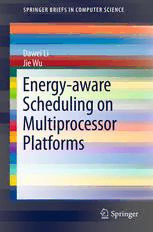
Energy-aware Scheduling on Multiprocessor Platforms PDF
Preview Energy-aware Scheduling on Multiprocessor Platforms
SpringerBriefs in Computer Science SeriesEditors StanZdonik PengNing ShashiShekhar JonathanKatz XindongWu LakhmiC.Jain DavidPadua XueminShen BorkoFurht VSSubrahmanian Forfurthervolumes: http://www.springer.com/series/10028 Dawei Li • Jie Wu Energy-aware Scheduling on Multiprocessor Platforms 123 DaweiLi JieWu DepartmentofComputer DepartmentofComputer andInformationSciences andInformationSciences TempleUniversity TempleUniversity Philadelphia,PA,USA Philadelphia,PA,USA ISSN2191-5768 ISSN2191-5776(electronic) ISBN978-1-4614-5223-2 ISBN978-1-4614-5224-9(eBook) DOI10.1007/978-1-4614-5224-9 SpringerNewYorkHeidelbergDordrechtLondon LibraryofCongressControlNumber:2012950310 ©TheAuthor(s)2013 Thisworkissubjecttocopyright.AllrightsarereservedbythePublisher,whetherthewholeorpartof thematerialisconcerned,specificallytherightsoftranslation,reprinting,reuseofillustrations,recitation, broadcasting,reproductiononmicrofilmsorinanyotherphysicalway,andtransmissionorinformation storageandretrieval,electronicadaptation,computersoftware,orbysimilarordissimilarmethodology nowknownorhereafterdeveloped.Exemptedfromthislegalreservationarebriefexcerptsinconnection with reviews or scholarly analysis or material supplied specifically for the purpose of being entered and executed on a computer system, for exclusive use by the purchaser of the work. Duplication of this publication or parts thereof is permitted only under the provisions of the Copyright Law of the Publisher’slocation,initscurrentversion,andpermissionforusemustalwaysbeobtainedfromSpringer. PermissionsforusemaybeobtainedthroughRightsLinkattheCopyrightClearanceCenter.Violations areliabletoprosecutionundertherespectiveCopyrightLaw. Theuseofgeneraldescriptivenames,registerednames,trademarks,servicemarks,etc.inthispublication doesnotimply,evenintheabsenceofaspecificstatement,thatsuchnamesareexemptfromtherelevant protectivelawsandregulationsandthereforefreeforgeneraluse. While the advice and information in this book are believed to be true and accurate at the date of publication,neithertheauthorsnortheeditorsnorthepublishercanacceptanylegalresponsibilityfor anyerrorsoromissionsthatmaybemade.Thepublishermakesnowarranty,expressorimplied,with respecttothematerialcontainedherein. Printedonacid-freepaper SpringerispartofSpringerScience+BusinessMedia(www.springer.com) Preface Multiprocessorplatformsplayanimportantroleinmoderncomputationalsystems, andappearinvariousapplications,rangingfromenergy-limitedhand-held/battery- powered devices to large data centers. As their performance increases, energy consumption in these systems also increases significantly. Dynamic Voltage and Frequency Scaling (DVFS), which allows processors to dynamically adjust the supplyvoltageandtheclockfrequencytooperateondifferentpower/energylevels, is considered an effective way to achieve the goal of saving energy. Recently, energy-aware task scheduling on DVFS multiprocessor platforms has been a hot topic. Our work in this book surveys existing researches that have been done on thistopic.We noticethatenergy-awareschedulingproblemsareintrinsicallyopti- mizationproblems,the formulationsof whichgreatly dependon the platformand taskmodelsunderconsideration.Thus,weclassifyexistingworksaccordingtotwo key dimensions, namely, homogeneity/heterogeneity of multiprocessor platforms and the task types under consideration. Under this classification, other sub-issues are also included in this book, namely, slack reclamation, fixed/dynamic priority scheduling,partition-based/globalscheduling,taskpreemption/non-preemptionand application-specific power consumption, etc. Our work provides an overall and comprehensivesurveyonenergy-awareschedulingonmultiprocessorplatforms. Philadelphia,PA,USA DaweiLiandJieWu v Contents 1 Introduction ................................................................... 1 2 SystemModel.................................................................. 3 2.1 TaskModels.............................................................. 3 2.2 DVFSModels............................................................ 5 2.3 PlatformModels ......................................................... 7 2.4 OtherRelatedConcepts.................................................. 8 3 SchedulingonHomogeneousDVFSMultiprocessorPlatforms.......... 13 3.1 Frame-BasedTasks ...................................................... 13 3.2 TaskswithPrecedenceConstraints...................................... 20 3.3 PeriodicTasks............................................................ 23 3.4 SporadicTasks ........................................................... 37 4 SchedulingonHeterogeneousDVFSMultiprocessorPlatforms......... 41 4.1 Frame-BasedTasks ...................................................... 42 4.2 TaskswithPrecedenceConstraints...................................... 47 4.3 PeriodicTasks............................................................ 48 5 RelatedWork.................................................................. 53 6 ConclusionandFutureDirections .......................................... 55 References.......................................................................... 57 vii Chapter 1 Introduction Abstract This chapter introduces the energy consumption issue in modern computational multiprocessor platforms and describes the basic concept of Dynamic Voltage and Frequency Scaling (DVFS). For ease of understanding and further discussions on multiprocessor platforms, important concepts related to energy-aware scheduling on uniprocessor platforms are also made clear first. For multiprocessor platforms, we mention that several new issues will also be consideredbesidestheonesconsideredforuniprocessorplatforms.Theorganization ofthebookisprovidedinthelastparagraph. The primary design goal of computational systems has been about system performanceimprovement,whereperformanceisoftencharacterizedbyprocessing speedforagiventask.However,astheperformanceincreases,energyconsumption in these systems also increases significantly. High energy consumption becomes a key problem;in the mobile energy-limiteddevices, it results in a short lifetime, andinlargedatacenters,itresultsinhighelectricitybills.Thus,energy-awaretask schedulingisdrawingmoreandmoreattention. Dynamic Voltage and Frequency Scaling (DVFS), which allows processors to dynamicallyadjustthesupplyvoltageortheclockfrequencytooperateondifferent power/energy levels, is considered an effective means of achieving the goal of savingenergy.DVFSisalsocalledDynamicVoltageScaling(DVS)invariousother literature,because,inmostcases,thesupplyvoltagehasaone-to-onecorresponding relation with the operating frequency, and thus dynamically adjusting the supply voltageisequivalenttodynamicallyadjustingtheclockfrequency.Throughoutthis book,forconsistency,andtoeliminateanyconfusion,onlythetermDVFSisused. In past decades, energy-aware task scheduling in DVFS uniprocessor systems attractedalotofresearchinterest.Generally,theactivepowerconsumption,when a processor is running tasks, includes both dynamic power (due to switching activity)andstaticpower(duetoleakagecurrent).Whenstaticpowerconsumption is negligible, the active power consumption of a processor can be approximated D.LiandJ.Wu,Energy-awareSchedulingonMultiprocessorPlatforms, 1 SpringerBriefsinComputerScience,DOI10.1007/978-1-4614-5224-9 1, ©TheAuthor(s)2013 2 1 Introduction as proportional to the cube of the clock frequency, while the actual execution time of a CPU cycle is just inversely proportional to the clock frequency. Thus, the energy consumption per CPU cycle is proportionalto the square of the clock frequency.Foragiventask,itscomputationrequirementisquantifiedastherequired numberofCPUcyclesandisregardedasfixed,moreorless.Hence,slowingdown the processing speed (clock frequency) as much as possible, without missing its predefineddeadline,will significantlyreducethe totalenergyconsumption.When staticpowerisnon-negligible,usingahigherfrequencytoexecutetasksandthenput theprocessorinshutdown/sleepmode,wherepowerconsumptionismuchless,may savemoreenergy.Hence,atradeoffbetweenslowdownandshutdownisrequired. Multiprocessor platforms are playing important roles in modern computing systems,andtheysignificantlyimprovetheperformanceofcomputationalsystems. Consequently, energy consumption in these systems also increases significantly. Recently,energy-awareschedulinginmultiprocessorDVFSsystemshasbecomea hotresearchtopicinbothacademicandindustrialsocieties.Inadditiontoslowdown and shutdown, in multiprocessor systems, it is also important to determine the optimalnumberofprocessorsthatshouldbeused.Thisisbecause,ontheonehand, byusingmoreprocessors,theseprocessorscanoperateatlowerfrequencies,leading to the reduction of dynamic energy consumption; on the other hand, using more processorswill increase the static energyconsumption.Besides, determininghow toassigntaskstodifferentprocessors,anddecidingwhetherandtowhichprocessor tomigratetasks(ifmigrationisallowed),areallimportantissuesinenergy-aware schedulingonmultiprocessorplatforms.Suchissuesinenergy-awareuniprocessor schedulingastaskpreemption,slackreclamation,andpriorityconstraints,etc.,also becomemorecomplicatedonmultiprocessorplatforms. Generally, energy-awarescheduling problems on multiprocessor platforms can be formulated as optimization problems, the formulationsand solutions of which greatlydependontheplatformandtaskmodelsthatareunderconsideration.Thus, theclassificationofexistingworksdiscussedin thisbookaremainlybasedonthe platformtypesandtaskmodelsconsidered. In this book, we will first present the system models dealt with in most research works in Chap.2, which consists of task models, platform models, and other concepts related to energy-aware scheduling on multiprocessor platforms. A comprehensive survey of energy-aware scheduling problems are presented for homogeneous platforms and heterogeneous platforms in Chaps.3 and 4, respec- tively. For homogeneous platforms in Chap.3, problems are further classified according to four task models, namely, frame-based tasks, tasks with precedence constraints,periodictasks,andsporadictasks.Forheterogeneousplatforms,since, to the best of our knowledge, little has been done for energy-aware scheduling of sporadic tasks, we only survey problems for frame-based tasks, tasks with precedenceconstraints,andperiodictasks.Someworksthataresimilartooursare provided and discussed in Chap.5. The conclusion and our future directions are presentedinChap.6.
